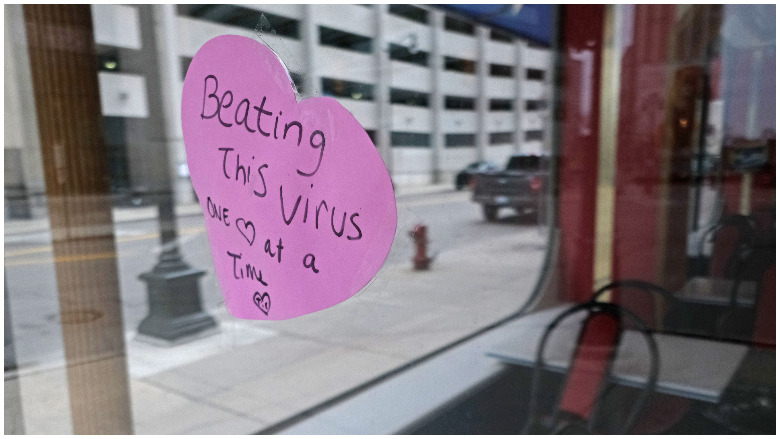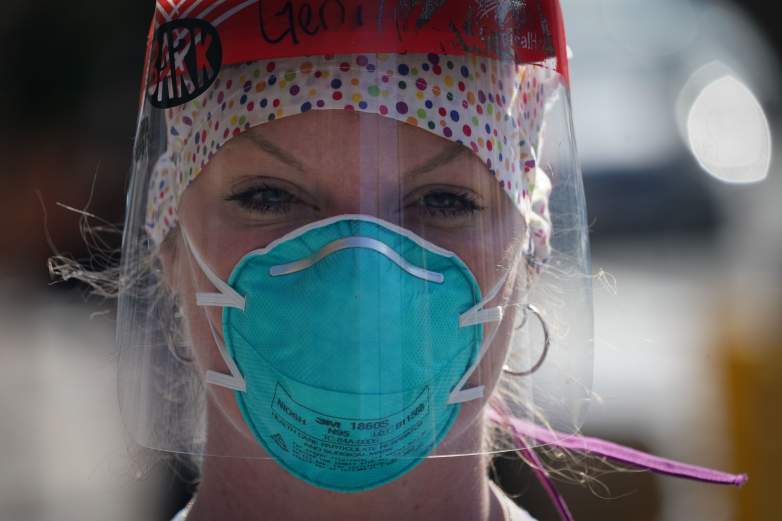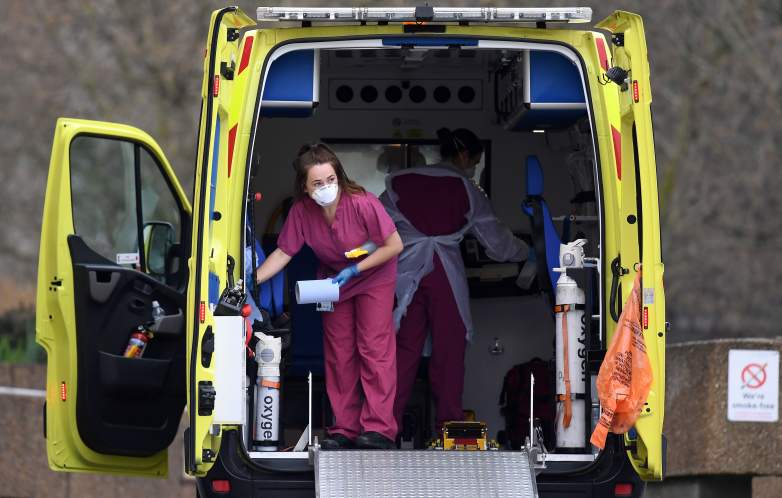
Google has changed its logo to honor public health workers and researchers in the scientific community with the phrase “thank you coronavirus helpers.” Below you can find multiple ways that you can help them too.
The Google Doodle was unveiled on April 6, 2020. Google announced that it’s only the first in a series. “As COVID-19 continues to impact communities around the world, people are coming together to help one another now more than ever. Over the coming weeks, we’re launching a Doodle series to recognize and honor many of those on the front lines,” Google wrote, adding: “Today, we’d like to say: To all the public health workers and to researchers in the scientific community, thank you.”

The “thank you coronavirus helpers” Google Doodle.
Words matter, but actions do too, of course. Here are some ways that you can show your support to offer a tangible thank you to support coronavirus helpers:
Donate Masks & Medical Supplies for Healthcare Workers

Photo by BRYAN R. SMITH/AFP via Getty ImagesA member of the medical staff listens as Montefiore Medical Center nurses call for N95 masks and other critical PPE to handle the coronavirus (COVID-19) pandemic on April 1, 2020 in New York. – The nurses claim “hospital management is asking nurses to reuse disposable N95s after long shifts” in the Bronx.
We’ve all read the stories of healthcare workers saying they don’t have proper supplies. Here are some ways you can donate masks and medical supplies to them if you have any:
Mask Match allows you to send masks to healthcare workers without leaving your house. Mask Match also has a GoFundMe page to help with its costs.
Donate your PPE (Personal Protective Equipment) here.
Masks for Docs is determined to get protective equipment to doctors as quickly as it can.
Get Us PPE has a similar mission.
Med Supply Drive does too.
The Seattle Mask Brigade is working on efforts there.
Make your own masks at home so you don’t take them from healthcare workers.
Make masks for healthcare providers.
Check out GoFundMe pages for individuals affected by COVID-19 here.
Help Project Dignity. The group works on “finding smart devices and getting them in the hands of hospital workers to connect families.”
Donate to Relief Funds & Help Non-Profits

Photo by DANIEL LEAL-OLIVAS/AFP via Getty ImagesStaff wearing PPE of gloves and face masks, as a preactionary measure against COVID-19, disinfect an ambulance after it arrived with a patient at St Thomas’ Hospital in north London, on April 1, 2020
Here are some ways you can give back to helpers or people in need, becoming a helper yourself:
Help Direct Relief. Its website says, “Direct Relief works in the U.S. and internationally to equip doctors and nurses with life-saving medical resources to care for the world’s most vulnerable people.”
Contribute to the International Medical Corps. “International Medical Corps is scaling up as this outbreak continues to grow with equipment, training, disease surveillance operations and more. Please help us contain this deadly virus and save lives with a gift today,” the site explains.
Donate to NYC Health + Hospitals.
Donate to the World Health Organization’s Solidarity Response Fund for coronavirus.
Give to GlobalGiving’s coronavirus relief fund.
Help Team Rubicon. Its website says, “Team Rubicon serves communities by mobilizing veterans to continue their service, leveraging their skills and experience to help people prepare, respond, and recover from disasters and humanitarian crises.”
Donate to the Center for Disease Philanthropy. Its website explains, “Help CDP support preparedness, containment efforts, response and recovery activities for those affected by COVID-19 and for the responders.”
Help Feeding America stock local food banks.
Help No Kid Hungry make sure that kids out of school still have meals to eat.
Help the CDC Foundation with a donation. Its website reads, “The CDC Foundation’s Emergency Response Fund enables CDC to strengthen critical global health security needs and respond immediately to public health emergencies such as the current novel coronavirus (COVID-19). Your gift allows CDC to better prepare for and respond to crisis situations by providing flexibility to meet both immediate and planned needs that would not otherwise be readily available.”
Donate blood through the Red Cross.
Donate to help Boys and Girls clubs become hubs of support in their communities stressed by COVID-19. “Club kids and their families are facing trying times with the abrupt closure of schools – from food insecurity to scrambling to find safe quality childcare for parents who must remain working, like first responders and healthcare workers,” the club’s website says.
Follow Safety Guidelines to Help Stop the Spread of COVID-19
Safety guidelines, such as stay at home orders in various states, are there for a reason. Yes, they’re part of a major effort by the U.S. government and other nations to “flatten the curve” so cases of coronavirus don’t happen all at once and overwhelm the hospital systems. This also protects “coronavirus helpers” – doctors, paramedics, nurses, police and fire officials, and the like – who are on the frontlines dealing with coronavirus cases.
The best way to protect them is to help flatten the curve (which the Google Doodle shows on a chart) by following safety rules and taking them seriously. Google offers these tips:
STAY home as much as you can
KEEP a safe distance
WASH hands often
COVER your cough
SICK? Call ahead
Google further suggests: “Wash your hands regularly for 20 seconds, with soap and water or alcohol-based hand rub. Cover your nose and mouth with a disposable tissue or flexed elbow when you cough or sneeze. Avoid close contact (1 meter or 3 feet) with people who are unwell. Stay home and self-isolate from others in the household if you feel unwell. Don’t touch your eyes, nose, or mouth if your hands are not clean.”
The Centers for Disease Control and Prevention offers similar suggests for warding off the spread of COVID-19. “The best way to prevent illness is to avoid being exposed to this virus,” writes CDC, explaining, “The virus is thought to spread mainly from person-to-person.” Here’s how it spreads, according to CDC:
Between people who are in close contact with one another (within about 6 feet). Through respiratory droplets produced when an infected person coughs, sneezes or talks. These droplets can land in the mouths or noses of people who are nearby or possibly be inhaled into the lungs. Some recent studies have suggested that COVID-19 may be spread by people who are not showing symptoms.
CDC suggests that everyone clean their hands often, suggesting:
Wash your hands often with soap and water for at least 20 seconds especially after you have been in a public place, or after blowing your nose, coughing, or sneezing. If soap and water are not readily available, use a hand sanitizer that contains at least 60% alcohol. Cover all surfaces of your hands and rub them together until they feel dry. Avoid touching your eyes, nose, and mouth with unwashed hands.
You should avoid close contact with people who are sick. “Stay home as much as possible. Put distance between yourself and other people. Remember that some people without symptoms may be able to spread virus,” CDC says. “Keeping distance from others is especially important for people who are at higher risk of getting very sick. Cover your mouth and nose with a cloth face cover when around others. You could spread COVID-19 to others even if you do not feel sick.”
The organization also advises that “everyone should wear a cloth face cover when they have to go out in public, for example to the grocery store or to pick up other necessities. Cloth face coverings should not be placed on young children under age 2, anyone who has trouble breathing, or is unconscious, incapacitated or otherwise unable to remove the mask without assistance. The cloth face cover is meant to protect other people in case you are infected. Do NOT use a facemask meant for a healthcare worker. Continue to keep about 6 feet between yourself and others. The cloth face cover is not a substitute for social distancing.”
Covering coughs and sneezes matters. “If you are in a private setting and do not have on your cloth face covering, remember to always cover your mouth and nose with a tissue when you cough or sneeze or use the inside of your elbow. Throw used tissues in the trash,” says the CDC. “Immediately wash your hands with soap and water for at least 20 seconds. If soap and water are not readily available, clean your hands with a hand sanitizer that contains at least 60% alcohol.”
Cleaning and disinfecting is another way to stay safe. “Clean AND disinfect frequently touched surfaces daily. This includes tables, doorknobs, light switches, countertops, handles, desks, phones, keyboards, toilets, faucets, and sinks,” says CDC. “If surfaces are dirty, clean them: Use detergent or soap and water prior to disinfection.”
READ NEXT: Can You Get Coronavirus From Money?